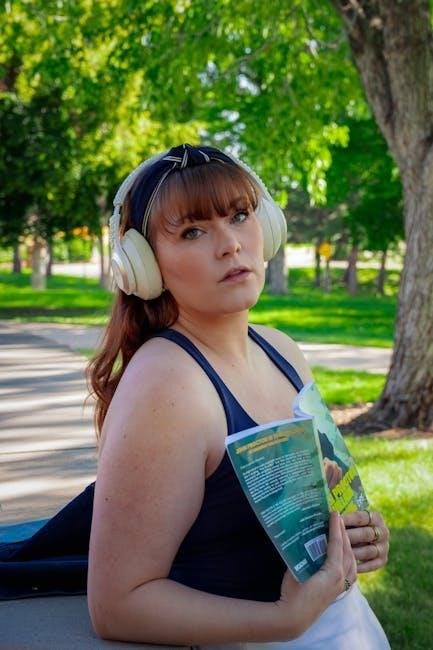Robert Schumann’s “Widmung” (Op. 25, No. 1) is a beloved lied composed in 1840, dedicated to his wife Clara. Its poetic text by Friedrich Rückert expresses deep love and devotion, set to a lyrical melody with rich piano accompaniment, making it a cornerstone of Romantic vocal music.
1.1 Historical Context and Significance
Composed in 1840, “Widmung” (Op. 25, No. 1) is part of Schumann’s “Myrthen” collection, dedicated to his wife Clara. This period marked a prolific time for Schumann, showcasing his mastery of lieder. The piece reflects his deep emotional connection to Clara, who was both his muse and wife. Its lyrical beauty and expressive depth have made it a cornerstone of Romantic-era vocal music, enduring as a testament to Schumann’s artistic genius.
1.2 Dedication to Clara Schumann
“Widmung” was composed as a gift for Clara Schumann, Robert’s wife and muse, to celebrate their marriage. It is the first piece in his “Myrthen” collection, a testament to their deep love. Clara, a talented pianist, often performed the work, further cementing its emotional significance. The dedication reflects their profound bond, with the music embodying the passion and devotion they shared, making it a cherished piece in Schumann’s oeuvre.

Musical Composition and Structure
“Widmung” is a lyrical lied for voice and piano, showcasing Schumann’s mastery of expressive melody and harmonious accompaniment. The piece features a flowing, arpeggiated piano part that underscores the vocal line, creating a sense of intimacy and emotional depth. Its structure blends poetic text with musical phrasing, exemplifying the Romantic era’s emphasis on lyrical expression and technical refinement in composition.
2.1 Original Version for Voice and Piano
Composed in 1840, “Widmung” is a lied for voice and piano, set to Friedrich Rückert’s poem. The original version features a lyrical vocal melody with a flowing piano accompaniment, blending emotional depth and technical refinement. The piece is dedicated to Clara Schumann, showcasing Robert’s romantic devotion. Its moderate vocal range and expressive phrasing make it accessible to singers while retaining dramatic intensity. The piano part complements the voice with arpeggiated chords and harmonic richness, creating an intimate dialogue between the two instruments.
2.2 Instrumental Arrangements (Piano, Guitar, etc.)
Franz Liszt’s piano transcription of “Widmung” (S. 566) is the most famous arrangement, transforming the vocal piece into a virtuosic piano solo. Other instrumental versions include guitar and flute arrangements, offering fresh interpretations while preserving the emotional core. These arrangements are widely available as PDF downloads, allowing musicians to explore the piece in various formats, from solo performances to ensemble adaptations, while maintaining its original Romantic essence and technical appeal.
Lyrics and Poetic Inspiration
Friedrich Rückert’s poem, “Widmung,” provides the lyrical foundation, expressing profound love and devotion. Schumann’s setting enhances the emotional depth, translating poetic intimacy into musical eloquence.
3.1 Friedrich Rückert’s Poetry
Friedrich Rückert’s poem, “Widmung,” is a deeply emotional and intimate expression of love and devotion. Its lyrical and heartfelt language inspired Schumann to create a musical masterpiece. Rückert’s words, filled with passion and tenderness, perfectly complement Schumann’s melodic genius, resulting in a piece that resonates with emotional depth and poetic beauty, making it a cornerstone of Romantic-era music.
3.2 Emotional Depth and Interpretation
The emotional core of “Widmung” lies in its heartfelt lyrics and Schumann’s expressive melody. The piano accompaniment adds layers of feeling, making it a favorite for performers. Its emotional richness allows for varied interpretations, and its availability in PDF formats and arrangements for instruments like piano or guitar ensures its accessibility and enduring appeal in Romantic music.

Sheet Music Availability and Formats
Sheet music for “Widmung” is widely available in PDF and MIDI formats, offered by platforms like Mutopia, Sheet Music Direct, and others, with arrangements for piano, guitar, and vocal scores.
4.1 Free PDF Downloads
Free PDF downloads of “Widmung” by Robert Schumann are readily available on platforms like Mutopia, Sheet Music Direct, and Musopen.org. These downloads offer high-quality sheet music for piano, vocal, and guitar arrangements, allowing musicians to practice and perform seamlessly. Many websites provide these scores free of charge for personal and educational use, ensuring accessibility to this timeless piece of Romantic-era music.
4.2 Commercial Sheet Music Platforms
Commercial sheet music platforms like Sheet Music Direct, Musicnotes, and others offer “Widmung” in various formats, ensuring high-quality prints and digital downloads. These platforms provide licensed versions tailored for pianists, vocalists, and instrumentalists, often featuring professional arrangements. Musicians can access both original and transcribed scores, making it a reliable source for those seeking authentic and performance-ready sheet music of Schumann’s timeless composition.

Famous Arrangements and Transcriptions
Franz Liszt’s piano transcription (S. 566) is the most renowned, while arrangements for guitar, violin, and flute have also gained popularity, broadening its appeal.
5.1 Franz Liszt’s Piano Transcription (S. 566)
Franz Liszt’s transcription of “Widmung” (S. 566) transforms Schumann’s original lied into a virtuosic piano piece, preserving the emotional depth while showcasing Liszt’s technical brilliance. The arrangement maintains the lyrical essence of the vocal line, transcribing it into intricate piano arpeggios and harmonies. Liszt’s masterful interpretation has made this version a staple in piano repertoire, celebrated for its technical challenges and expressive richness, offering pianists a profound connection to Schumann’s romanticism through Liszt’s unique lens.
Performance and Interpretation Tips
6.1 Vocal Techniques
Emphasize dynamic control and phrasing to convey the emotional depth of Rückert’s poetry. Focus on clear articulation and expressive breathing to highlight the lyrical qualities of the melody.
When performing “Widmung,” focus on expressing the emotional depth of Friedrich Rückert’s text. Use legato singing to maintain a smooth, lyrical flow, and employ subtle vibrato to enhance expressiveness. Pay attention to dynamic contrasts, using pianissimo for intimate moments and crescendo for passionate climaxes. Articulate German diction clearly, especially in complex passages, to preserve the poem’s meaning. Balance vocal power with sensitivity to the piano accompaniment, ensuring a unified interpretation that highlights the work’s Romantic essence.
6.2 Piano Accompaniment Dynamics
The piano accompaniment in “Widmung” requires nuanced dynamics to support the vocal line. Begin with a gentle, leggiero touch in the arpeggiated figures to create a delicate texture. Use crescendo and diminuendo to mirror the emotional intensity of the lyrics. Pay attention to dynamic markings like “mf” and “pp” to maintain balance with the voice. Employ rubato sparingly to enhance expressive moments, ensuring the accompaniment remains supportive without overpowering the melody. Follow the score’s phrasing and articulation closely for authenticity.

Digital Resources and Platforms
Access “Widmung” sheet music via platforms like Musopen, Mutopia Project, and Scribd. These sites offer free PDF downloads, ensuring easy access for musicians and enthusiasts worldwide.
7.1 Online Libraries and Archives
Online libraries like the International Music Score Library Project (IMSLP) and Mutopia offer free access to “Widmung” sheet music. These platforms provide high-quality PDF downloads, including arrangements for piano, voice, and guitar. Additionally, archives such as Scribd and Musopen feature transcriptions and interpretations by renowned artists, making them invaluable resources for both professional musicians and enthusiasts seeking to explore Schumann’s timeless composition.
7.2 Free Sheet Music Websites
Websites like Mutopia, Sheet Music Direct, and Musopen offer free PDF downloads of Schumann’s “Widmung.” These platforms provide high-quality scores, including arrangements for piano, voice, and guitar. Many sites feature transcriptions by notable artists, ensuring a wide range of interpretations. Users can access and print these scores effortlessly, making them ideal for musicians seeking free, reliable resources to explore and perform this beloved composition.
Cultural and Artistic Impact
Schumann’s “Widmung” deeply influenced Romantic-era music with its emotional depth and lyrical beauty, inspiring countless adaptations and modern performances, making it a timeless classic in classical music repertoire.
8.1 Influence on Romantic-Era Music
Robert Schumann’s “Widmung” had a profound impact on Romantic-era music, exemplifying the period’s emphasis on emotional depth and lyrical expression. Its innovative fusion of poetic text with rich, expressive melodies set a new standard for lieder. The piece inspired numerous adaptations, including Franz Liszt’s celebrated piano transcription, further cementing its influence. “Widmung” remains a cornerstone of Romantic vocal music, showcasing Schumann’s mastery of emotional nuance and lyrical beauty, and continues to inspire performers and composers today.
8.2 Modern Performances and Recordings
Robert Schumann’s “Widmung” remains a timeless favorite in modern performances, with its emotional depth resonating across generations. Contemporary artists often perform the piece in its original vocal-piano form or through Franz Liszt’s celebrated piano transcription. Digital platforms like Musopen and Sheet Music Direct offer free and paid versions, ensuring accessibility. Modern recordings highlight nuanced interpretations, blending traditional Romantic sensibilities with fresh artistic perspectives, keeping Schumann’s masterpiece vibrant and relevant in today’s musical landscape.

Educational Value
Schumann’s “Widmung” is a key educational resource, widely used in music schools for teaching vocal and piano techniques. Its intricate composition and emotional depth make it ideal for studying Romantic-era musical expressions, offering insights into both technical skill and artistic interpretation.
9.1 Use in Music Education
Schumann’s “Widmung” is frequently utilized in music education to teach vocal techniques, phrasing, and emotional expression. The piece’s lyrical melody and complex piano accompaniment provide a comprehensive study tool for both singers and pianists. Its availability in various formats, including PDF scores, allows educators to easily incorporate it into curricula. Additionally, the song’s historical context and poetic depth make it an excellent choice for analytical studies, enriching students’ understanding of Romantic-era music.
9.2 Analytical Studies of the Composition
Schumann’s “Widmung” offers rich material for analytical studies, with its intricate harmonies, expressive dynamics, and nuanced piano accompaniment. Analysts explore the interplay between the vocal line and piano, highlighting the piece’s emotional depth and structural complexity. The song’s use of motivic development and chromaticism underscores its Romantic character, while its text setting reveals Schumann’s mastery of lieder composition. These elements make it a focal point for scholarly exploration and performance analysis.

Technical Challenges for Musicians
Musicians face challenges in “Widmung,” including maintaining consistent vocal tone, intricate piano fingerwork, and balancing accompaniment with expressive dynamics, all while preserving the piece’s emotional depth.
10.1 Vocal Range and Expressiveness
The vocal range in “Widmung” demands precise control and emotional depth, with nuanced phrasing and dynamics. The singer must navigate the upper registers with clarity while conveying the poem’s intimate passion. Expressiveness requires subtle variations in tone and pitch, balancing power and delicacy to match the accompaniment’s complexity. Maintaining consistent breath support and diction is essential to project Friedrich Rückert’s poetic imagery effectively.
10.2 Instrumental Technique Requirements
The piano accompaniment in “Widmung” demands refined technique, including delicate arpeggios and legato passages. Dynamics range from soft, expressive chords to dramatic crescendos, requiring precise control. Instrumental arrangements, such as guitar versions, also need finger dexterity and nuanced phrasing. The pianist must balance technical accuracy with emotional depth, ensuring the melody flows naturally while supporting the vocalist. Coordination between instruments and voice is crucial for a unified, expressive performance.
Robert Schumann’s “Widmung” remains a timeless masterpiece, celebrated for its emotional depth and technical beauty. Its enduring popularity is evident in numerous arrangements and performances, solidifying its place in Romantic-era music. As a dedication to Clara, it symbolizes love and devotion, inspiring generations of musicians and audiences alike. The piece continues to be a cornerstone in classical repertoire, both in its original form and through transcriptions like Liszt’s, ensuring its legacy endures.


